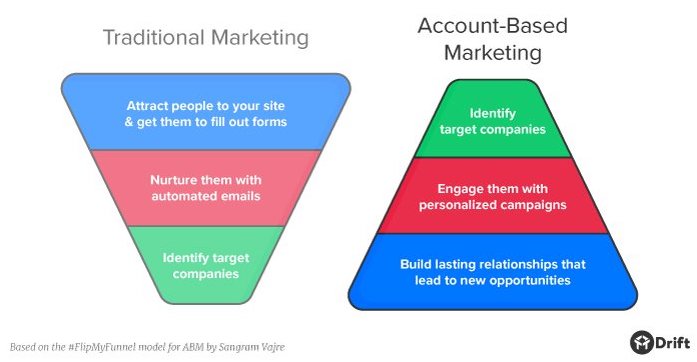Anyone working in any type of marketing in the last five years or so has probably noticed one big trend that’s stood out among many others: personalization. Even in some of the most traditional consumer-driven industries, like cleaning supplies and groceries, prospects want customized help to assist with the challenges they’re trying to solve by making a purchase.
According to McKinsey, over 7 in 10 buyers expect personalized interactions. If a prospect expects to get custom advice on cleaning a sink, they’ll definitely want information tailored specifically for them when buying a new product for their company.
Account-based marketing – often abbreviated as ABM – represents one of the best opportunities today’s marketers have for personalizing their efforts to improve conversion rates and prospect satisfaction. We’ve certainly noticed a surge in the number of clients we work with deploying personalization efforts at different places throughout their funnels.
As we’ll get into in this blog post, one of the other significant benefits of ABM is its versatility. You can shape ABM tactics to work well for your particular situation regardless of your industry, marketing goals, or company size.
What is Account-Based Marketing?
We’ve previously defined ABM on this blog as “Personalized campaigns that are designed to engage each account based on the marketing message on the specific attributes and needs of that account.” Adobe’s definition says ABM “uses the combined expertise of the marketing and sales teams to target select groups of accounts that require tailored marketing.”
Discussing combined expertise is particularly helpful since ABM shouldn’t be exclusively in sales or marketing. In an optimal setup, your sales and marketing teams contribute to ABM campaigns, making them more effective than they would be siloed to either department individually.
Finally, you can think about ABM visually using the “inverted funnel” model. Where a typical funnel is wide at the top and gradually gets narrower, an ABM strategy works the opposite way: the top narrow part represents a few target accounts, based on which you identify a larger number of people as possible buyers.
In an optimal setup, your sales and marketing teams contribute to ABM campaigns, making them more effective than they would be siloed to either department individually. Click To TweetHere is a helpful visual model that breaks down the above inversion in three steps, courtesy of Drift:

Why is ABM the Future?
There’s already been plenty of talk and advice on why and how marketers should use ABM. We believe this strategy is so effective that it will be a centerpiece of B2B marketing for the next five to ten years – if not longer.
What makes us so confident? A few critical factors.
ABM is Personalized
In a sense, ABM represents the highest possible level of personalization. When it comes to B2B, you can’t get more custom-made than tailoring something for one specific customer. In a world with ever-increasing marketing communications, advertising, and options for professional purchases, ABM is helping B2B buyers cut through the noise and get what they need. If they want to be successful, all business buyers must be somewhat selfish in focusing exclusively on their needs. It’s easy for some marketers to get frustrated by this, but when you think about it, being a professional buyer is inherently a selfish job. There are dozens, hundreds, or even thousands of people depending on the buyer to make a decision that enables them to do their jobs better. This necessity is why, when done properly, ABM can be like music to a prospect’s ears.
ABM Adds Maximum Value to Prospects
To continue from the point above, maximum personalization means maximum value. An easy comparison to make is within the realm of personal fitness. Anyone can sign up with a colossal gym, show up a few times a week, mess around with a few machines, and progress towards their fitness goals.
Now think about working with a personal trainer; who evaluates your specific goals, needs, and lifestyle to create a specific plan for your needs. The personal trainer requires a considerable investment of time and capital upfront, but you get more value while working towards the same goal.
Just like traditional mass-appeal marketing, getting plenty of value and getting in shape from working out on your own is still possible. But a personal trainer is like ABM – it’s created specifically for an individual to achieve the best possible results.
ABM is Highly Flexible
While the relatively broad definition of account-based marketing may make it difficult to understand without firsthand experience, the tradeoff is that it applies to almost any channel. Text-based marketing is usually most effective on a blog or social media site. Video marketing is usually best on a company website or video platform. The great thing about ABM is you can pair it with almost any type of marketing for great results – including the tactics mentioned above. Even as marketing and technology move towards tools like crypto and AI, ABM will be a viable strategy to deploy in these developing worlds.
How to Get Started With ABM
Hopefully, we’ve convinced you that ABM is a strategy worth pursuing. What may be less clear is how actually to implement it. The details of your execution depend on the specifics of your business, but we can provide three tips with pertinent examples to help you think about using ABM.
- Research. Of course, you’ll need to identify the specific accounts you want to target, but to do ABM properly, you must go deeper. How are they structured, and who makes final buying decisions? Who else is involved, and what’s their buying cycle? These are all questions to keep in mind during the research component of ABM.
- Identify pain points. Once you know your prospects’ blocks and challenges, you can map your funnel content to match them. Your map will then increase personalization and give your marketing a better chance of resonating with prospects – especially if you can identify their problems in their own language.
- Measure and iterate. It’s impossible to tell whether or not your ABM has been successful without tracking results. If possible, try choosing the same metrics to measure your everyday marketing efforts and see how they change when applied to your ABM campaigns. Conversions, appointments scheduled, follow-up emails, and clickthrough rates are just a few examples of numbers you might look to track to get a sense of your ABM campaign’s success.
Looking for some expert help with account-based marketing? Whether you’re new to the concept and want to start on the right foot or you’ve been doing it for a while and aren’t fully satisfied with the results, our team at FunnelEnvy can help. Our conversion rate optimization specialists have lots of experience assisting clients of all sizes with ABM tactics to ensure their marketing campaigns stand out and get noticed by the right audience. We’ll help you understand key concepts like attribution, lead scoring, and other metrics to get you on track for success with ABM.
To get in touch with us, click here to fill out a short quiz to get more information about our pricing and see how we can help.






